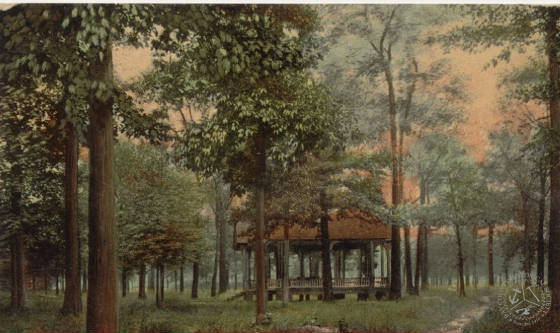
Image Source: Bay County Historical Society
“…pic-nics,
and pleasure gatherings of the city folks. Being so near the residence portion of the city, it is very handy and businessmen
and families can take their noonday meals there without the loss of much time.”
A description of Carroll Park found in the Bay City Daily Tribune, 1884
In the
19th century, during the Industrial Revolution the park was a symbol of health, beauty, and an inner-city getaway for all,
regardless of class. Cities had grown as individuals migrated from rural farms to urban centers to find work in factories.
This caused crowded conditions and a lack of “breathable space”. Fortunately for the citizens of Bay City, the
creation of Carroll Park offered an opportunity to escape the busy urban life. The park was much more wooded in the 19th century
and underwent many changes, including the addition of a duck pond, pedestrian bridge, and a Gazebo. Today, users of the park
can also enjoy the tennis courts, playground, picnic pavilion, and grills.
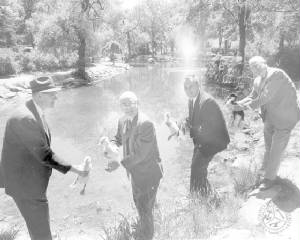
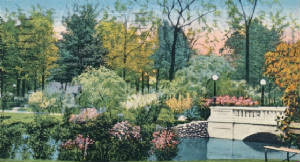
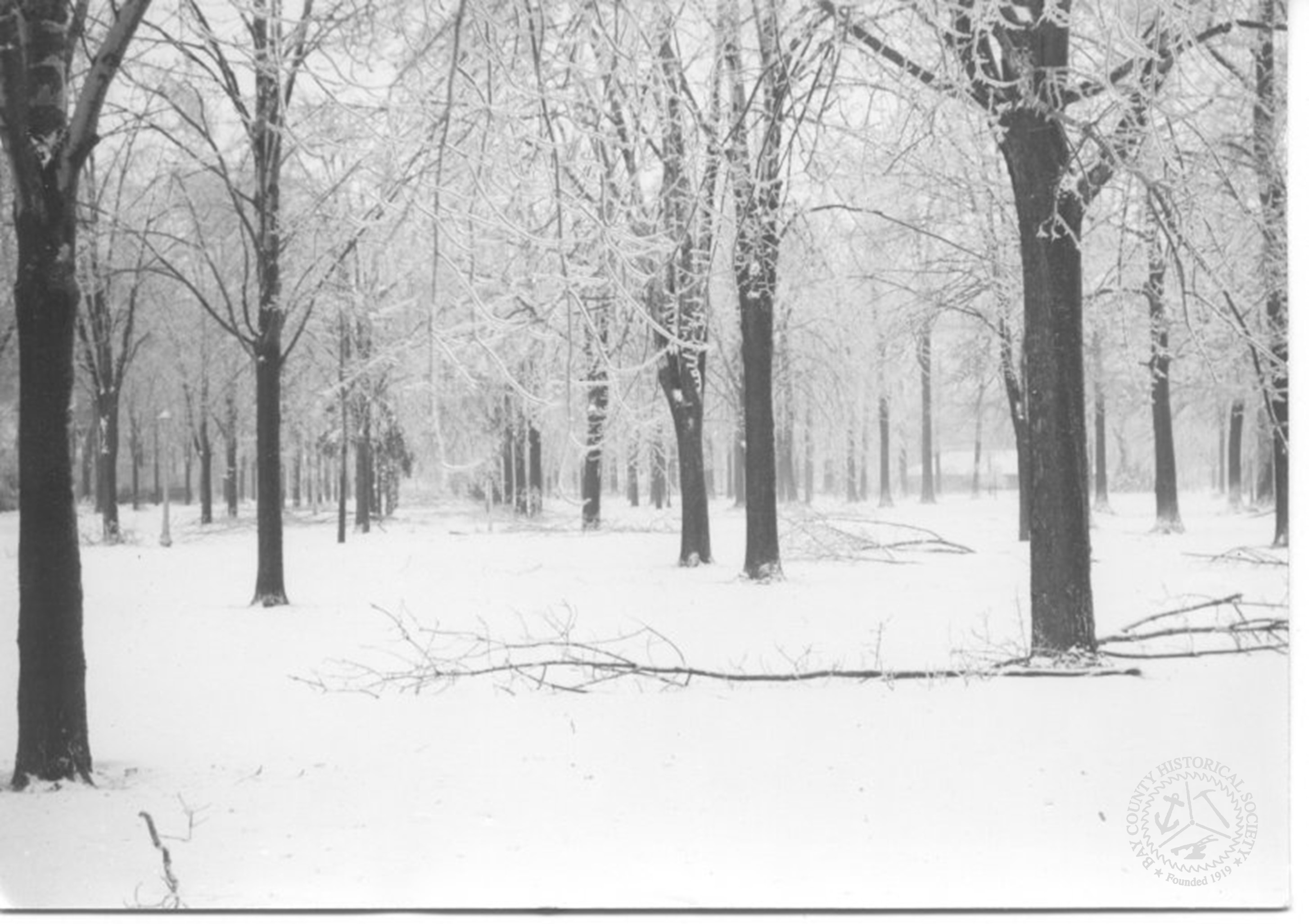
Images Source: Bay County Historical Society Photograph Collection
Left:
Carroll Park rotary Clup planetary ducks on pond in Carroll Park, June 19, 1963
Center: date unknown
Right: Carroll Park Ice Storm, March 9, 1942.
Carroll Park is one of Bay City’s
oldest parks, located in the Center Avenue Historic District, north of Center Avenue and about a mile east of downtown.
Its amenities include 3.7 acres of walkways, green spaces with large trees that offer shade from the sun, a pond, tennis
courts, a playground, a pavilion, and public bathrooms. Its west side is bounded by Park Avenue between Fourth and Third
Streets, on the north side by Carroll Road following the curve, and on the south side Groveland Road. The curvature of the
park and the platted area follows the curvature of the former Michigan Central Railroad line that ran along Livingston Road
(where the rail trail is now situated).
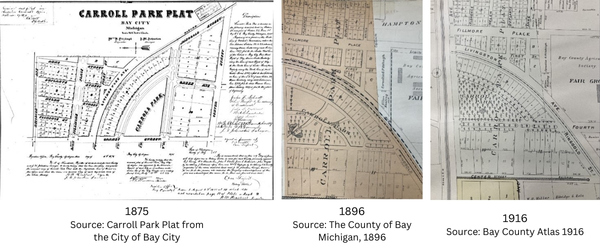
William D. Fitzhugh & Anne Carroll
In
1849, William D. Fitzhugh and his wife Anne Carroll came to what was Lower Saginaw, now Bay City from Livingston County, NY.
His father, Dr. Fitzhugh, and business partner Judge Charles Carroll came to the Saginaw Valley in 1834 to purchase and invest
in land. Dr. Fitzhugh owned land that would eventually make up West Bay City, and was a major proprietor in Lower Saginaw.
William looked after his father’s land interests and surveyed much of the land within this region for irrigation and
ditching to improve farm work. He even helped tend to the sick and dying during the Cholera outbreaks in the 19th century.
He lived on Third and Water Streets, but after a fire in 1850, he built a new home on the corner of Tenth and Washington (at
the present site of Bay City Hall). He sold this property to his brother, Daniel Fitzhugh, who later sold it to the City.
In 1866, William Dana Fitzhugh filed a new plat in the City encompassing most of the area
south of Center Avenue within the southeastern section of the current historic district. By 1869, the “Fitzhugh Addition”
was platted to the area north of the 1866 plat. The only large plat remaining was the Carroll Park Plat which came in 1875.
The Fitzhughs were the founders of the Trinity Protestant Episcopal Church. Anne was one
of the five original communicants at the first service in Saginaw and continued to hold membership at the Bay City location.
In his old age, William Fitzhugh decided to return to Livingston County, NY where he passed away in 1889. He is buried there
with his wife Anne, who passed in 1905.
According to History of Bay County Michigan,
1905, the Fitzhugh’s gifted a “valuable tract of land” to Bay City, which was owned and presented to Anne
by her father Judge Carroll. Later, it was given to the City and named “Carroll Park” in honor of Anne and her
father’s work in the area.
Frederick Law Olmsted: Where is the Evidence? In the past, it was rumored that Frederick Law Olmsted designed the park. However, it is not listed on the National
Association for Olmstead Parks website, and there is no evidence to support this belief. Olmstead designed Belle Isle in Detroit,
New York City’s Central Park, and numerous others across the US and Canada.
**Note:
January’s Art & History: Carroll Park program was a collaboration between Studio 23/ The Arts Center and the Bay
County Historical Society. The content of this blog article was taken from Sam Fitzpatrick’s presentation for the program.
Resources:
Bay City Tribune, November 1887
Bay County
Historical Museum Archives
Expanded Center Avenue Local Historic District Bay City, Bay
County, Michigan Prepared On Behalf Of The City Of Bay City And The Center Avenue Local Historic District Study Committee,
419 N. Madison Avenue Bay City, Michigan 48708 Prepared By Commonwealth Cultural Resources Group, Inc. 2530 Spring Arbor Road
Jackson, Michigan 49203
Find A Grave. Found at: https://www.findagrave.com/
Human Benefits of Green Spaces. The University of Delaware School of Agriculture & Natural Resources. Found
at https://www.udel.edu/academics/colleges/canr/cooperative-extension/fact-sheets/human-benefits-of-green-spaces/
Robinson, Elaine H. (2011) Architectural Historian Evelyn Tidlow, Project Manager Sam Fitzpatrick’s personal
photos The Bay City Times








